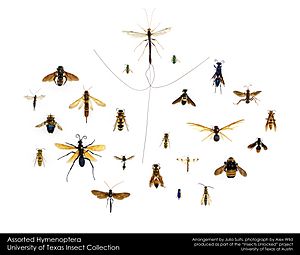Arthur Wilson Stelfox facts for kids
Quick facts for kids
Arthur Wilson Stelfox
|
|
|---|---|
| Born |
Arthur Wilson Stelfox
15 December 1883 Belfast, Ireland
|
| Died | 19 May 1972 (aged 88) Newcastle, County Down, Northern Island
|
| Spouse(s) | |
| Children | George Stelfox |
| Awards |
Honorary Fellow of the Linnaen Society
|
| Scientific career | |
| Fields | Natural history, Architecture |
Arthur Wilson Stelfox (born December 15, 1883 – died May 19, 1972) was an amazing Irish scientist and architect. He was an expert on many types of insects, especially Hymenoptera (like bees and wasps). He also knew a lot about Mollusca (snails and slugs) that live in freshwater.
Arthur also helped us learn about Irish plants and ancient animal remains found in Ireland.
Contents
Arthur Stelfox's Early Life and School
Arthur Stelfox was born in Belfast on December 15, 1883. His parents were Jennie McIlwaine and James Stelfox. He went to school at Campbell College in Belfast.
After school, he studied to become an architect in Ireland and England. He became a member of a professional group for architects in 1908.
Arthur loved nature from a young age. His father, who was part of the Belfast Naturalists' Field Club, encouraged him. He was also inspired by Robert John Welch, a famous photographer. Arthur collected his first nature specimens when he was just 15 years old. These are now kept in a museum!
Arthur Stelfox's Marriage and Family
Arthur officially joined the Belfast Naturalists' Field Club in 1903. In 1908, he became the club's secretary. In 1909, a talented naturalist named Margarita Mitchell was asked to help him.
Margarita was also a great scientist. She did important work on Mycetozoa, which are like tiny slime molds. Arthur and Margarita got married in 1914. They had three children together. Sadly, their daughter and youngest son passed away when they were children.
Arthur and Margarita often explored nature together. In 1925, they found a rare slime mold called Diderma lucidum in Ireland. Later, in 1947, they found another rare slime mold, Lepidoderma carestianum, in Scotland.
Arthur Stelfox's Career in Natural History
Around 1908, Arthur helped with a big project called the Clare Island Survey. He visited the island many times. He studied and wrote about the freshwater snails and slugs found there. In 1912, he became a member of the Royal Irish Academy.
One of his most important papers was about a type of mollusc called Pisidium. This paper, published in 1918, changed how scientists studied these tiny creatures.
In 1920, Arthur was finally able to work full-time on his passion. He got a job at the National Museum of Ireland. He became an Assistant Naturalist, specializing in Hymenoptera (bees, wasps, and ants).
Arthur took great care of the museum's collection of Hymenoptera. He made sure all the specimens were correctly identified and labeled. He also linked them to old notes from another famous scientist, Alexander Henry Haliday. Even though he specialized in insects, Arthur was an expert on many other things. He wrote papers on nine different insect groups. He was also known for his knowledge of molluscs and Irish plants.
From 1924, Arthur and his assistant, Eugene O'Mahony, were in charge of all the museum's animal collections. This meant Arthur often helped identify animal remains found at ancient sites across Ireland. His work taught scientists a lot about what Ireland was like thousands of years ago.
Arthur also discovered and described many new species of Irish plants and animals. In his free time, he continued to go on field trips. He built up his own large collections of molluscs and insects.
Even though he was a brilliant scholar, Arthur turned down offers of honorary doctorates. However, in 1947, he was honored by the Linnean Society. Arthur retired from the National Museum of Ireland in 1948. But he never stopped exploring and collecting plants, molluscs, and insects.
Arthur Stelfox's Amazing Collections
Arthur Stelfox donated many of his valuable collections to museums. In 1951, he gave his collection of Pisidium molluscs to a scientist who then gave them to the Museum of Zoology, University of Michigan.
In 1966, he gave his huge collection of over 90,000 Hymenoptera specimens to the Smithsonian Institution. This collection was called "The largest and most complete collection of Irish Hymenoptera ever made." Other important documents from Arthur are kept by different museums and his family.
The Ulster Museum also has a collection from Arthur. It includes his plant specimens. It also has the slime mold specimens collected by his wife Margarita and her friend Margaret Williamson Rea.
Arthur Stelfox's Later Years
Arthur Stelfox passed away in the hospital on May 19, 1972, after a short illness. His wife, Margarita, had passed away the year before.
Animals Named After Arthur Stelfox
Some animals have been named in honor of Arthur Stelfox. One example is Heterospilus stelfoxi, which is a type of parasitoid wasp.


